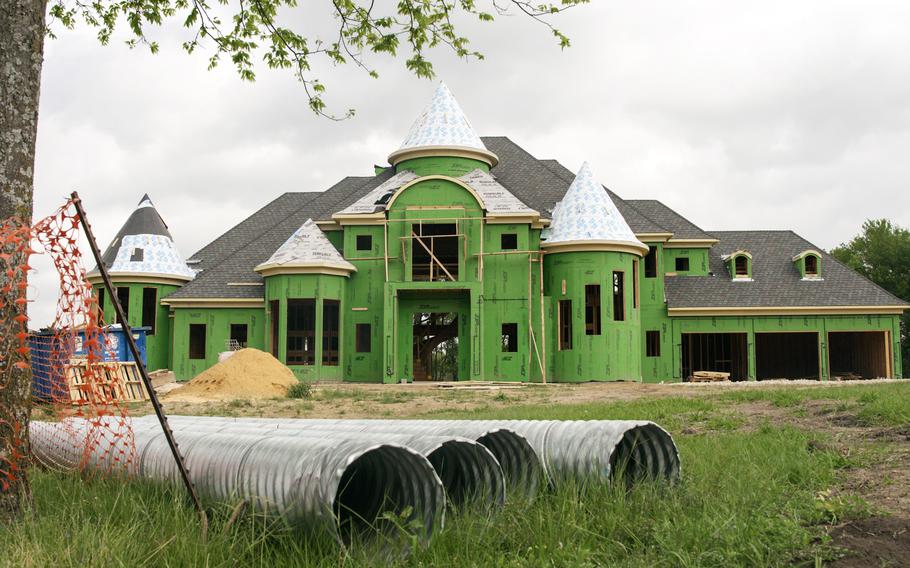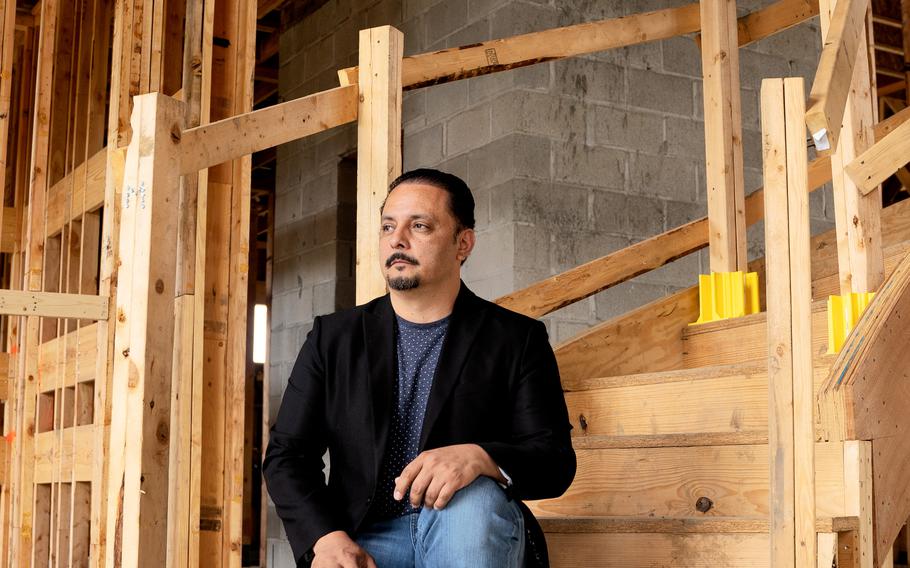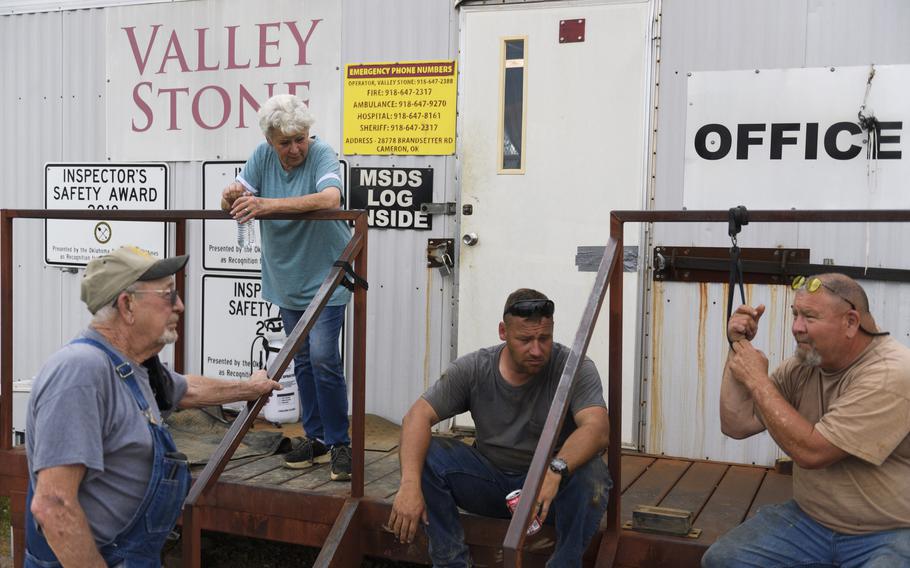
The shell of the Dallas dream home, as of May 3. Rising costs from factors in the COVID economy made the homebuilding slower and more expensive than the owners, builders and suppliers had thought. (Kaci Merriweather-Hawkins for The Washington Post )
Stars and Stripes is making stories on the coronavirus pandemic available free of charge. See more stories here. Sign up for our daily coronavirus newsletter here. Please support our journalism with a subscription.
Carrie and Nate LaChance were watching HGTV from their home in Orlando in 2018 when montages of stunning, palatial houses popped up on the screen. They were hooked. And so the couple decided to move to the Dallas area — sight unseen — and build their dream home.
What they discovered seemed serendipitous: an untouched, lakefront lot, which they bought that year for $260,000. They started their building plans in 2020, and Carrie, a model, started posting updates from the "Castle" on Instagram, taking her 1.1 million followers along for the groundbreaking, the selection of a 24-karat gold sink, and the arrival of glittery stone slabs named "Silver Mist."
Four years since they began, the LaChances' home isn't finished. Like a structure that withstands rain, snow, wind and hail, their home has been bombarded by every twist and turn in the pandemic economy. Labor shortages. Housing price run-ups. Supply chain snarls. Manufacturing problems. Inflation.
The house is still missing windows. And every piece of the house — every plank of wood, every nail, every appliance — has cost far more than planned. The initial budget started around $3 million, but a torrent of global forces have added hundreds of thousands of dollars to the final product.
The local lumber supplier's costs doubled since the pandemic began, then fuel costs ramped up tenfold after Russia's invasion of Ukraine. An appliance company was hammered by an ongoing chip shortage and production issues that pinched things like refrigerators and washing machines. No one can plan for what their products or services will cost.
"It was like a chain reaction," said Joshua Correa, a Dallas native and the LaChances' home builder. "Everybody started charging more — for everything."
The chaos swirling around the housing market has swept up millions of families — from those chasing their dream homes to those trying to become first-time buyers. Few builders or construction workers have been spared, especially in the Dallas area, which has some of the highest inflation rates in the country.
This is the story of how the unusual forces shaping the COVID economy collide under one (very expensive) Texas roof.
When the LaChances moved to Texas, they knew that finding their dream home would take patience and work. They looked for a plot of land and began sketching out what they'd want to include: a movie theater, a gym, a pool. In the meantime, they grew their businesses, including one that manufactures and sells a line of hosiery, lingerie and high heels.
Carrie's fans from her modeling career have been along for the ride. Every day, she'll get messages from her online followers asking how she and Nate came up with the design or when they'll finally get to move in. Eventually, the LaChances' home will also host much of their work, so they can showcase their products and stage photoshoots.
Ultimately they are footing the bill for each delay or redrawn contract on their dream house. But they've also found themselves changing or adding details along the way, like a white and silver color scheme that shifted to gold.
"The longer you think of stuff you think, 'maybe I want this inside,'" Carrie said.
In the fall of 2021, the couple took out an additional $100,000 from the bank, thinking it would cover their unforeseen expenses. That cushion was gone by the end of the year.
Joshua Correa learned the ins and outs of home building as a teenager helping out with his dad's plumbing business. The Dallas native knew to follow a basic order of operations: Windows first, then the interior. But windows are now on a months-long delay. If he waits to install plumbing or utilities, he'd lose money every day. A tarp is often the next-best option.
As the main home builder and owner of the company Divino Homes, Correa has to coordinate all of his contractors, and account for their own unique supply chain issues or labor shortages. It used to take five months to build a basic house from the ground up. Now it takes 10 months, at least, he says. Contracts need rewriting as the costs of doing business, hiring workers and delivering products piles up.

Joshua Correa, founder of Divino Homes, is a home builder based in Dallas. “It was like a chain reaction,” said Joshua Correa, a Dallas native and the LaChance’s home builder. “Everybody started charging more — for everything.” (Kaci Merriwether-Hawkins for The Washington Post )
He's constantly scouring for workers who can pour concrete, frame a house or put in electrical wiring weeks in advance. If a framing crew shows up but the lumber crew doesn't, he risks losing the framing workers altogether.
"Due to the lack of manpower, once you add up my time lost, my carrying costs, overhead costs, all my delays, I'm at about $150,000 extra per house," Correa said.
Lumber: Initial budget, $105,000. Cost as of June 22, $177,000.
On a crisp, nearly-cloudless morning in November, the Castle's wooden framing was on its way up. Correa pointed to a stack of lumber planks sitting on the edge of the site, and summed up so many of his pandemic-era woes.
"In order for this to be sitting here, I had to put this order in three months ago," he said.
Correa is lucky to have a reliable, stocked supplier: Big D Lumber. For much of the pandemic, owner Garret Cockrell fielded 100 calls per day from builders desperate to get their hands on wooden panels or sheathing products. Cockrell has had no choice but to turn all new customers down. He can barely keep up with his existing clientele.
Cockrell, a Texas native, has worked in construction since he was a teenager framing houses alongside his uncle. He worked his way up to buy the lumber yard, and his dad now works for him.
For much of the pandemic, the lumber business has been mired in some of the worst global supply chain snarls of modern times. At various phases of the pandemic, lumber became a go-to commodity for economists and policymakers trying to explain their views on inflation in the economy, highlighting easing prices as supply chains slowly cleared.
While some lumber relief may have happened in the industry, Cockrell's overall costs haven't gone down. At times they've been roughly two times higher than before the pandemic, especially when accounting for fuel costs, labor and parts for the lumber yard's equipment.
Russia's invasion of Ukraine in February dealt only the latest blow. Energy and oil markets went into disarray, triggering higher prices for fuel and gasoline. For businesses with heavy transportation and utility costs, there was little room to absorb another shock.
"Fuel pricing is killing us," Cockrell said earlier this summer. "I used to spend $20,000 a month for our fleet on fuel. It's now costing me $200,000 for our deliveries and daily operations. It's our cost of doing business. We just make less money."
Stone: Initial budget, $27,500. Cost as of June 2022, $39,000
Slabs of "Silver Mist" twinkle in the sunlight at the Castle. Eventually, the blue sandstone with streaks of brown will cover the outside of the house. But for weeks, it's been sitting in the LaChances' lot, because progress has been so long delayed.

From left, Johnny and Donna Webb, Trent Sewell and Jim Boatright catch up on at the end of their shift at Valley Stone Quarry in Cameron, Okla. Finding enough workers has been a challenge, says co-owner Donna Webb. (Michael Noble Jr. for The Washington Post)
The 100 tons of stone came from a quarry in Cameron, Okla. There, co-owner Donna Webb starts work before daybreak, along with Valley Stone's 16 employees who work across the quarry's 140 acres.
Webb said the area has enough stone left to last at least 10 years. But finding enough labor — from truckers to pit workers — has been an enormous strain. Webb blames a drop in immigration, plus historic levels of government stimulus during the pandemic, for making it so hard to hire.
She's raised wages at least 20% to stay competitive with the rest of the construction industry, but even so, she is constantly toggling between keeping staff and getting stone where it needs to go.
"If you want 'em, you got to pay 'em," Webb said. "We're not different than any other industry out there."
Between the lack of freight drivers and the high cost of fuel, her transportation costs have gone up about 30%. She buys fuel in bulk. In just six weeks, the cost of 2,500 gallons shot up from $7,900 to $10,000. Prices for a pallet of wire are up also 30% from a year ago — "worth more than one whole truckload of stone," she said. And there's only so much she can do to raise her prices. Specialty stone is often considered an "add on," not a necessity, when it comes to construction.
She worries that the economy will slow down so abruptly that it will dip into recession and spell unknown consequences for the housing market. Her fears have grown as mortgage rates rise.
"At a 6 percent mortgage rate, you darn skippy, there's gonna be a whole lot of people who can't pay for their houses," Webb said. "I think it's gonna be a little bit scary by the end of the year. I think a slowdown is coming. I hesitate to call it a recession, but everybody else is calling it one.
Appliances: Initial budget, $65,000. Cost as of June 2022, $78,000
The LaChances put in an order for their state-of-the-art refrigerator in September 2021. It won't arrive until March 2023.
In a bit of luck, they were able to snag the model sitting in the showroom at FACETS Appliances, Kitchen and Bath, where general manager Guy Minnix aims for "97 percent availability." That's the company goal he sets to make sure customers have everything they need to get their homes up and running, from washers and dryers to sinks to light fixtures.
"You could pick up product every day," Minnix said. "That was life pre-pandemic."
But lately, plumbing products need to be ordered three to seven months in advance. Cabinets have needed a 12- to 24-week buffer.

Guy Minnix, the General Manager of FACETS, a home appliance store in Dallas, is pictured on June 24. One problem can knock out the whole supply chain: For example, during the Texas freeze and massive power outages, the factory making foam for refrigerator doors had to halt production, meaning an even longer wait for appliances. (Laura Buckman for The Washington Post)
Last year, Minnix added warehouse space so he could stock up on products as they became available. But even his best attempts have come at a cost. It's one thing to get your hands on items that are in such short supply. It's another to be able to keep up with the pricing changes by the time it arrives.
"In some cases, pricing changes before the ink dries on the receipt," Minnix said.
Minnix has worked in home appliances for 35 years, and much of the reason he's stayed in the Dallas-Fort Worth area is because most manufacturers have hubs or logistics centers nearby. But those networks have met a tough match in the COVID era, when shortages on the other side of the world can hold up just about anything.
If a single chip falls out of production, or a factory shuts down over a coronavirus outbreak, every rung of the supply chain must go find another vendor — no matter how long that takes or how costly that can be.
Models then need to be retested to make sure they're up to code. And there's no telling what will cause the next blow: In early 2021, for example, freezing temperatures in an unprepared Texas shut down factories that made foam for refrigerator doors, stalling production even more.
"If one domino falls out of the lineup, the upstream and down stream chaos is crazy," Minnix said.
___
The housing market may be cooling, and fears of a recession may be ramping up. But construction at the Castle, and in so much of North Texas, presses on.
Minnix says demand is still high, and his company can pivot to supplying remodeled homes if new construction slows. Correa, the home builder, plans to finish 17 houses this year.
"Business is still good," Cockrell, of Big D Lumber said. "We're still blessed to be in Texas."
Meanwhile, Carrie and Nate LaChance have big plans for their first night in the house — whenever that may be. They'll fire up the popcorn machine and settle into their movie theater. After a long wait, they'll cue up a Game of Thrones marathon, and push play.